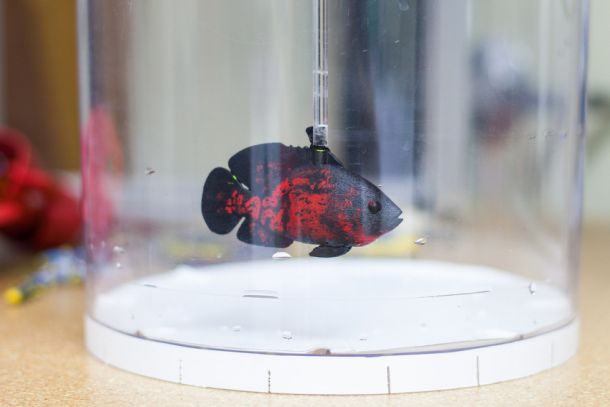Researchers Pair Robotics and Information Theory to Better Understand Predator and Prey Relationships

By comparing the swimming reactions of zebrafish (the prey) to the red tiger oscar (the predator, shown above) against the reactions of the zebrafish when confronted by a robot that looked and swam like the real thing, researchers at NYU Tandon concluded that coupling the research techniques of robotics with information theory will advance the understanding of predator-prey interactions.
BROOKLYN, New York – With help from robotic fish, researchers at the New York University Tandon School of Engineering are demonstrating how information theory can offer insight into the cause-and-effect relationships between predator and prey in the animal kingdom.
In a paper published in the American Institute of Physics’ Chaos: An Interdisciplinary Journal of Nonlinear Science, the research team led by Maurizio Porfiri, a professor of mechanical and aerospace engineering at NYU Tandon, validated the use of information theory to study predator-prey interactions. Through the use of robotic fish, the research provides a foundation for controlled experiments of causation within such interactions.
“Within a context of two entities — the predator and prey — seeking entirely different outcomes, robotics provides us with a tool for validating the concept of transfer entropy to discover cause-and-effect relationships and to answer certain biological questions,” Porfiri said. “The question we want to ultimately understand is, if we put together a predator and its prey, how they are influencing each other? How does the predator’s behavior change due to the presence of the prey, and how does the presence of the predator change the response of the prey?”

NYU Tandon engineers created a biomimetic robot that looked and swam like a real red tiger oscar.
Transfer entropy examines the transfer of information between two entities and has become widely applied in fields such as neuroscience and economics, but it is only recently emerging as a tool for studying animal behavior. The research detailed in the paper explores how a combination of robotics and transfer entropy can offer new insight into the analysis of predator-prey interactions and improve our understanding of fear and anxiety.
The paper, “Information Theory and Robotics Meet to Study Predator-Prey Interactions,” was written by Porfiri, Visiting Research Fellow and lead author Daniele Neri, NYU Tandon Dynamical Systems Laboratory Manager and Research Scientist Tommaso Ruberto, and Tandon undergraduate researcher Gabrielle Cord-Cruz.
In previous experiments, Porfiri and fellow researchers demonstrated the validity of robotic stimuli for experiments on animal behavior, showing that zebrafish exhibited an equivalent response to both live and robotic replicas of other zebrafish and predators.
Their robotics-based platform allows for manipulating and precisely controlling interactions better than is possible when using only live animals. In the case of their latest experiments, the team exposed live prey — zebrafish — to both a live red tiger oscar and a 3D version of the predator fish. The zebrafish swam freely within an arena-like setup around both the real and robotic predator, which in both cases was confined to the middle of the tank. The robot travelled on a dynamic and customizable trajectory that was pre-programmed to mimic the live fish’s typical predatory movements to incite a response within the zebrafish.
The researchers tracked the zebrafish responses to both the replica and the live predator. By eliciting a controlled fear response within the zebrafish from the robotic stimulus, the research demonstrated how transfer entropy can isolate the one-directional cause-and-effect relationship between a robotic replica and the zebrafish. On the other hand, experimenting with live predators, they found a two-directional interaction between the zebrafish and the predator, in which each was influencing the behavior of the other.
Further developments to their innovative robotic platform included engineering the robotic predator to react to the zebrafish’s movements in real time for future experiments. This will allow researchers to further manipulate the interaction between the robotic predator and the zebrafish such that the zebrafish will cause the behavior of the predator.
Porfiri and his team said they hope future studies will reveal more about how animals communicate with one another, as well as provide insights into the evolutionary aspects of social behavior and what determinants elicit fear and anxiety-related responses among zebrafish and even other animals, including humans.
Note: Images available at http://dam.engineering.nyu.edu/?c=1966&k=7a52a85aaa
About the New York University Tandon School of Engineering
The NYU Tandon School of Engineering dates to 1854, the founding date for both the New York University School of Civil Engineering and Architecture and the Brooklyn Collegiate and Polytechnic Institute (widely known as Brooklyn Poly). A January 2014 merger created a comprehensive school of education and research in engineering and applied sciences, rooted in a tradition of invention and entrepreneurship and dedicated to furthering technology in service to society. In addition to its main location in Brooklyn, NYU Tandon collaborates with other schools within NYU, the country’s largest private research university, and is closely connected to engineering programs at NYU Abu Dhabi and NYU Shanghai. It operates Future Labs focused on start-up businesses in downtown Manhattan and Brooklyn and an award-winning online graduate program. For more information, visit engineering.nyu.edu.



